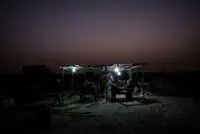Gan Chin Lees No Place For Diaspora (oil on linen, 2015). It is on show at his solo exhibition In-between at Richard Koh Fine Art 229 in Kuala Lumpur.
An old man lies on a street corner, desperately curled up for warmth. A group of workers break their backs lifting loads of oil palm fruit, all in exchange for a paltry sum of payment. Two men cut the neck of a chicken for food, while a young girl looks on the distance, uncertain about her future in a culture that is alien to her.
These are scenes from the lives of migrants – we see them everywhere, on our streets, in our workplaces, in our restaurants. They do the thankless jobs that everyone shuns, and a lot of our local businesses could not thrive without their contributions.




